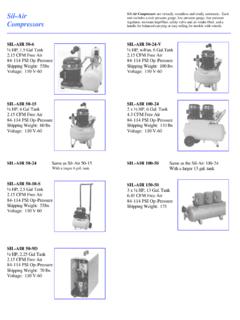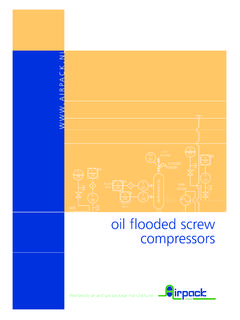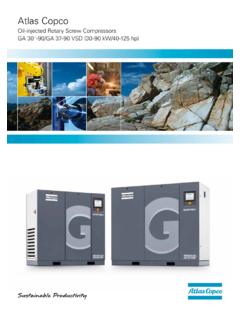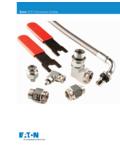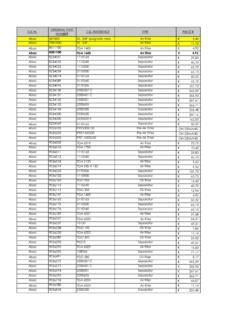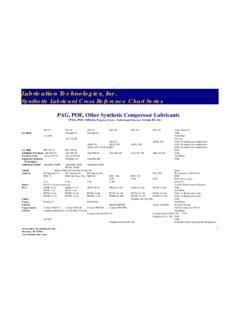Transcription of CONSIDER THESE SAFETY-INSTRUMENTED SYSTEM BEST …
1 Special ReportSPONSORED BYCONSIDER THESESAFETY-INSTRUMENTED SYSTEMBEST PRACTICES 2 TABLE OF CONTENTS CONSIDER HIPS for Reactive Processes 3 Such SAFETY-INSTRUMENTED systems offer advantages over pressure relief valvesGet the Most Out of Your HART SIS 7 Several HART parameters and best practices ensure its capabilities are fully realizedPerform Proof Tests with Confidence 14 Modern method improves efficiency, reduces errors, and meets compliance requirementsAD INDEX Emerson Process Management 3 CONSIDER HIPS for Reactive Processes Such SAFETY-INSTRUMENTED systems offer advantages over pressure relief valves By Angela E. Summers, , , president of SIS-TECH SolutionsAN UNCONTROLLED reaction can cause over-pressure in a vessel and thus lead to significant safety hazards. Industry standards from the American Petroleum Institute and the American Society of Mechanical Engineers provide criteria for the design and protection of vessels from rupture and damage caused by excess relief valves (PRVs) generally are used to meet API Recommended Practice 521 [1] and ASME Boiler and Pressure Vessel Code, Section VIII [2].
2 However, safety instrumented systems (SIS) called high integrity protection systems (HIPS) provide an attractive alternative in many cases. This article dis-cusses how to assess, design and implement an PRACTICEIn conventional design, the primary means of protec-tion against vessel overpressure is a PRV. It is a simple mechanical device that opens when pressure exceeds a set level. The pressure is relieved through the PRV to the atmosphere or to a contained collection SYSTEM such as a flare, scrubber or thermal boast relatively high integrity, as long as they are properly sized, located, inspected and maintained. Table 1 summarizes reliability data for a single-valve relief SYSTEM , as published in Guidelines for Process Equipment Reliability Data [3]. It shows substantial uncertainty in the failure to open on chemicals and their associated processes present complex scenarios for PRV design.
3 Small de-viations in reactant concentration or reaction condi-tions can put the reaction on a path that the process design, control SYSTEM and operator procedures can-not adequately manage. Unfortunately, many PRVs are improperly sized for reactive processes, because relief rate calculations often are based on a design and operational envelope that ignores potential reac-tion paths that are not well incidents, including those at Georgia Pacific (Columbus, Ohio, 1997), Morton Inter-national (Paterson, , 1998), Concept Sciences (Hanover Township, Pa., 1999), Chevron Phillips Chemical Co. (Pasadena, Texas, 1999) and BP Amoco (Augusta, Ga., 2001), have proved that there are reactive scenarios under which a PRV is ineffective. They point to a number of general sce-narios in which PRVs should not be considered: Reaction generates pressure at an uncontrol-lable rate ( , runaway reaction or decomposi-tion) such that an impractically large vent area is required or, in the worse case, an adequately sized PRV is not possible; Reaction takes place in a localized area ( , hot spots), propagating pressure at a rate so fast that containment is lost before PRV is able to act; Reaction occurs in a localized area, raising 4 temperature above thermal decomposition point and causing an internal detonation or fire; Reaction produces, during normal operation, materials that partially or completely block PRVs.
4 A nd Polymerization reaction continues as material is being relieved through PRV into lateral headers, plugging the relief device or lateral , the very nature of the reactive process often makes a PRV impractical. For such cases, HIPS should be investigated as a means to supplement the PRV for overpressure ANALYSISS uccessful implementation must be based on a haz-ard analysis of each potential overpressure scenario. The analysis should follow a structured systematic approach, using a multidisciplinary team. It should document the event propagation from the initiat-ing cause to the final consequence (also referred to as the overpressure scenario ). The analysis must examine operating and upset conditions that result in overpressure. It must include a thorough review of each step involved in startup and shutdown, in addition to normal operation.
5 For batch and semi-batch processes, scrutinize each step of the operation using typical deviations and batch-oriented deviations, such as skipped steps, steps out of sequence, steps incomplete, steps at wrong time, recipe incorrect, analysis should include a detailed ex-amination of reactive scenarios and brainstorm-ing on potential reaction paths that could lead to high pressure. Examine all reaction paths, including those that may require multiple errors or failures to begin propagating. Once the reac-tion paths are understood, HIPS can be designed to address each reaction scenario. In many cases, only one or two HIPS are required for mitigation of all potential reaction CRITICAL CONDITIONSA safety requirement specification (SRS) describes how and under what conditions the HIPS will mitigate each overpressure scenario; it includes a functional logic description with trip set points and device fail-safe state.
6 Choosing when and under what conditions to trip the unit is probably the most difficult decision to make in the design of the HIPS. For reactive processes, the design is often complicated by the process dynamics and by intricate process variable design may use single process variables when the reaction path is relatively easy to detect. For example, on high temperature the HIPS will stop the catalyst feed or, on high pressure it will inject reaction kill solution. Single process variables also can prevent the start-up of the reactor under unsafe operational PRV TYPEFAILURE TO OPEN ON DEMANDL owerMeanUpperSpring 0 E - 0 0 0 02 PRV FAILURE TO OPEN ON DEMAND 5 conditions. For example, the catalyst cannot be added until a fixed volume of solvent, which serves as a heat sink, is in the process variables are used when the reaction path is more complex.
7 THESE HIPS often use flow/mass ratios, temperature/pressure relationships and kinetic calculations. While it is best to try to keep the HIPS as simple as possible, if the reaction paths are intricate, the HIPS complexity will using reactor kill systems, it may be pos-sible to use preemptive interlocks to prevent the reac-tion from progressing to the point where it must be killed. THESE interlocks may close reactor feeds, open a pressure control vent or close catalyst valves. If the temperature or pressure continues to increase after the preemptive interlock, a reactor kill is initiated. By us-ing a preemptive interlock, the plant is able to recover more quickly from the process upset and suffer less production loss and potential rate of pressure escalation must be compared to the HIPS response time to ensure that it is fast enough to prevent vessel overpres-sure.
8 The HIPS response time must be evaluated by considering the time it takes to sense that there is an unacceptable process condition; the scan rate and data processing time of the logic solver; and closure speed of the final element. The valve speci-fication must include the acceptable leakage rate, because this affects potential downstream pressure and relief loading. The valve actuator must provide sufficient driving force to close the final element under the worst-case upset pressure SRS also includes documentation of the safety integrity requirements, including the Safety Integrity Level (SIL) and anticipated testing interval. At a minimum, the integrity of the HIPS should equal that of a PRV. The data in Table 1 implies that the HIPS should be designed to meet either SIL-2 or SIL-3, depending upon the type of PRV.
9 However, bear in mind that the failure modes of a PRV and the HIPS differ. A PRV that fails to operate at the set pressure nevertheless may operate at a higher pressure, whereas HIPS is more likely to fail completely. The failure-to-open-on-demand uncertainty, coupled with the difference in the fail-ure modes, results in the majority of users setting an SIL-3 target for the HIPS. INTEGRITY AND ARCHITECTUREIt is important to recognize that the HIPS consists of the entire instrument loop from the field sensor through the logic solver to the final elements, along with support systems required for successful HIPS functioning, such as power, air or gas :1. Guide for Pressure Relievin and Depressuring Systems, Recommended Practice 521, American Petroleum Insti-tute, Washington, (1997).2. Boiler and Pressure Vessel Code, section VIII Pressure Vessels, American Society of Mechanical Engineers, New York, (1999).
10 3. Guidelines for Process Equipment Reliability Data, Center for Chemical Process Safety, American Institute of Chemical Engineers, New Yor, (1989).4. Functional Safety Electrical/Electronic/Programmable Electronic Safety Related Systems, Document IEC 61508, International Elecrotechnical Commission, Ge-neva, Switzerland(1998).5. Summers, , High Integrity Pressure Protective Sys-tems in Instrument Engineers Handbook , 3rd ed., CRC Press, Boca Raton, Fla. (2002).6. Summers, , Using Instrumented Systems For Over-pressure Protection, Chem. Eng. Prog., 95, p. 85 (Nov. 1999). 6 Process sensors. The process variables commonly measured in HIPS are pressure, temperature and flow. Most HIPS applications require one-out-of-two (1oo2) or 2oo3 voting transmitters for all field inputs. Redundant inputs enable the incorpora-tion of input diagnostics, significantly increasing the integrity of the field inputs.










